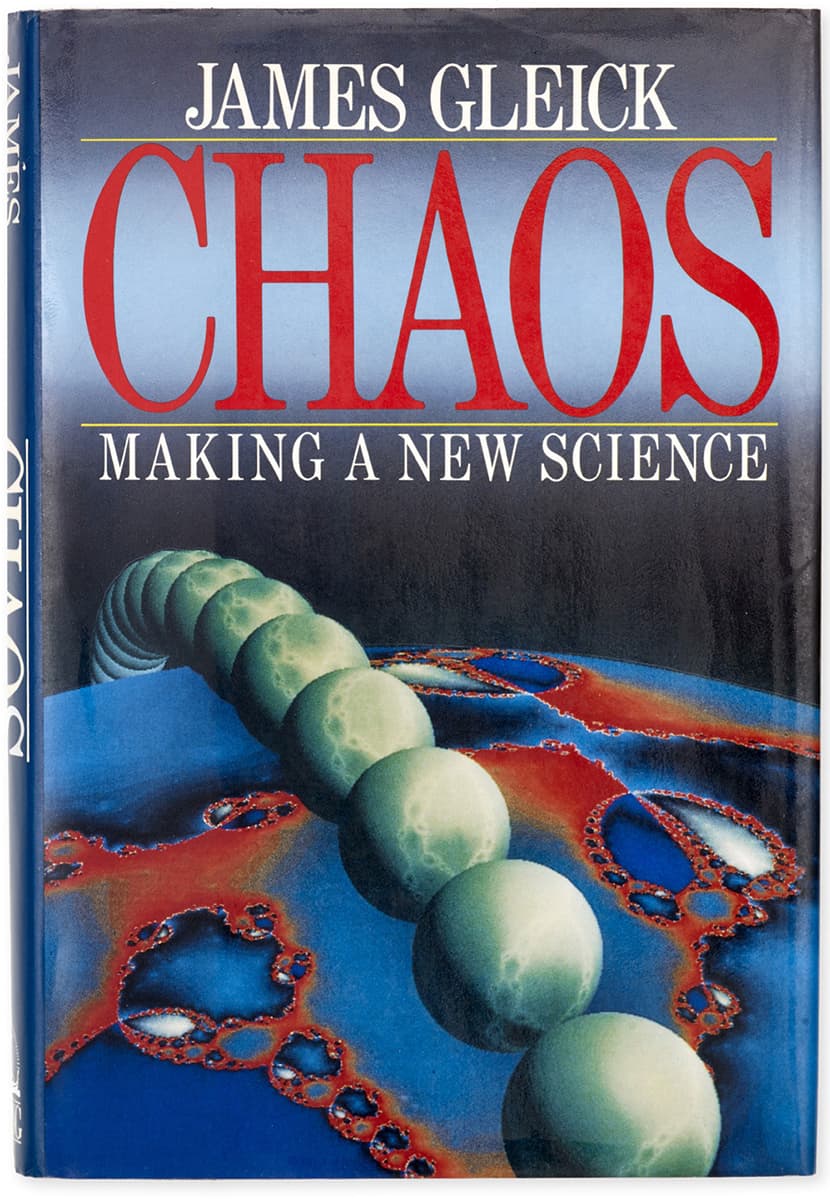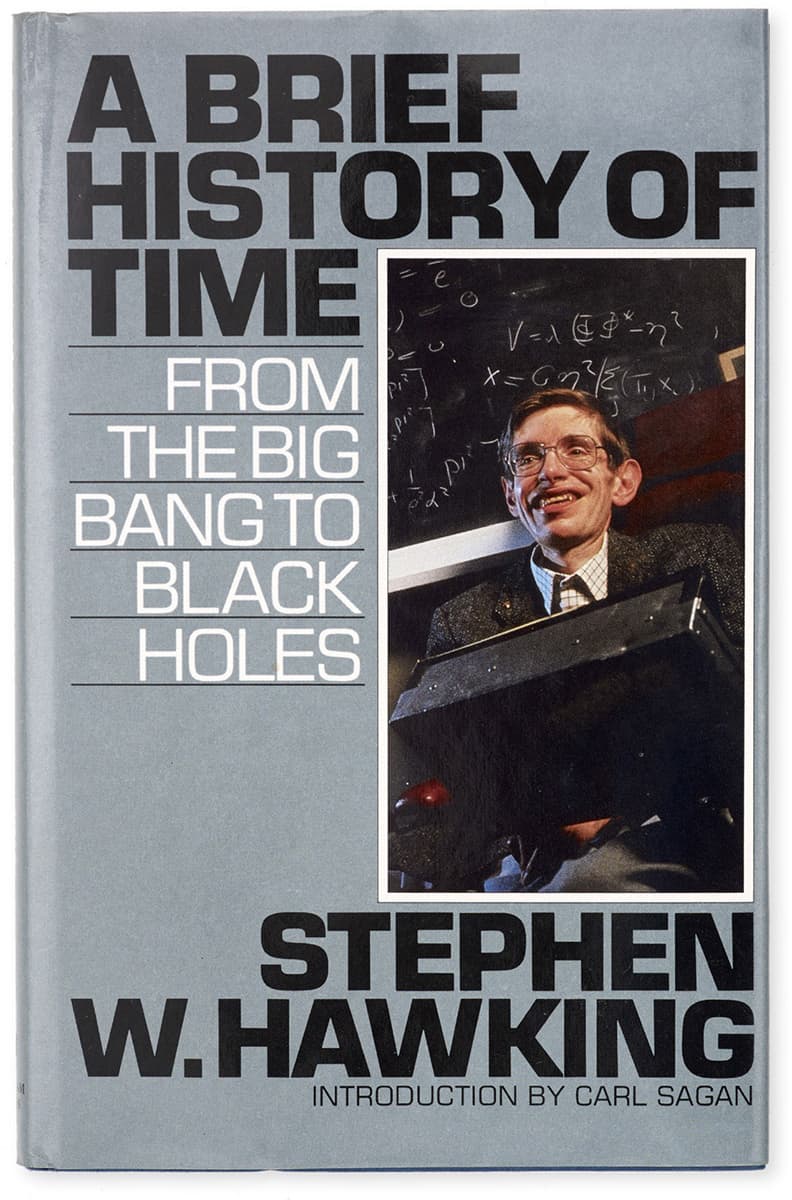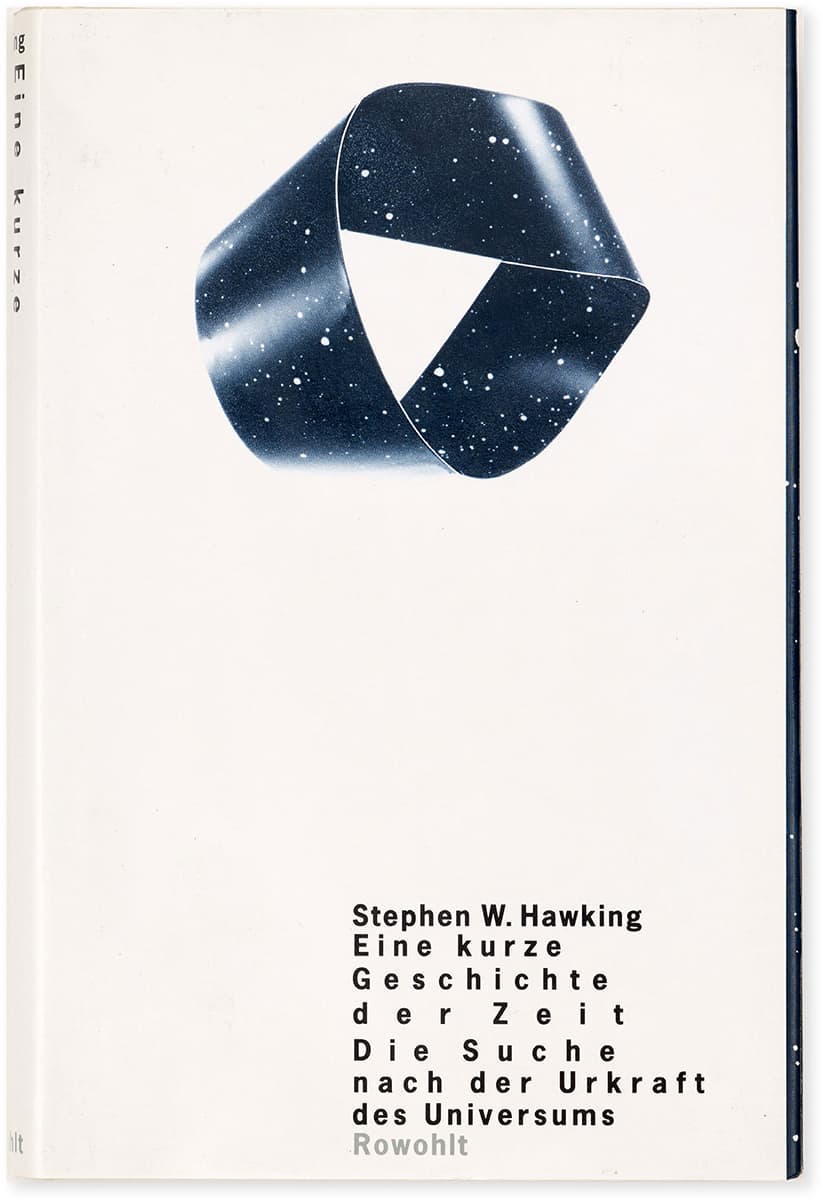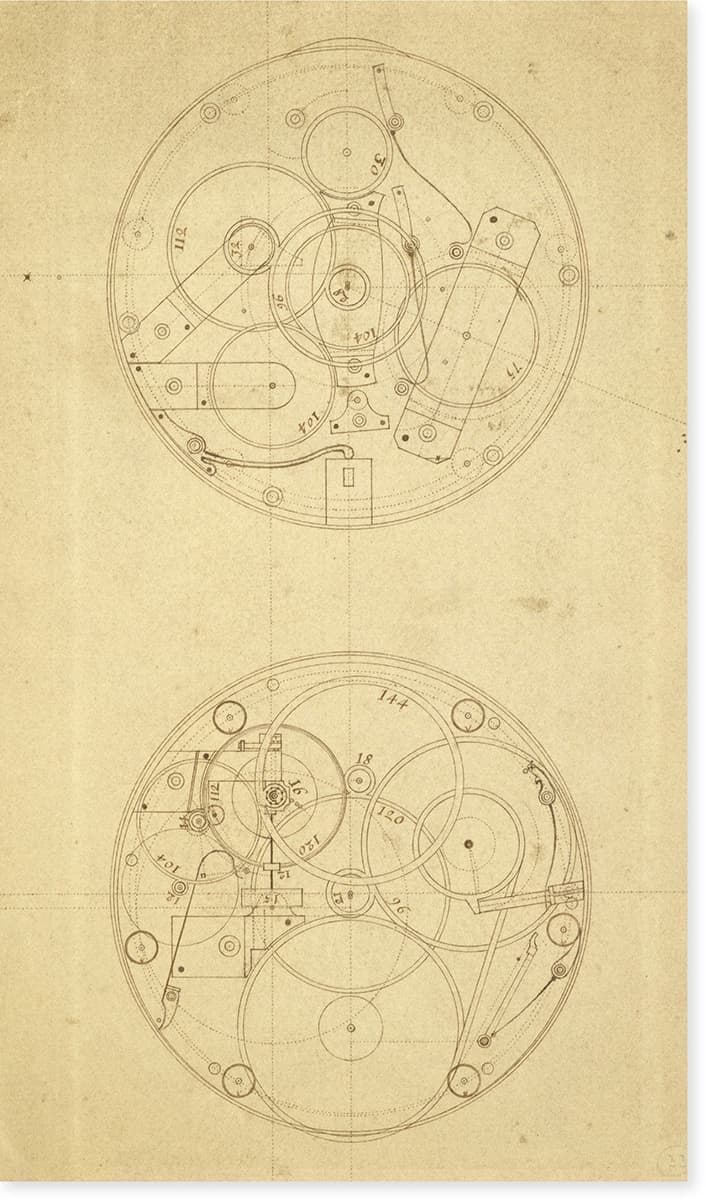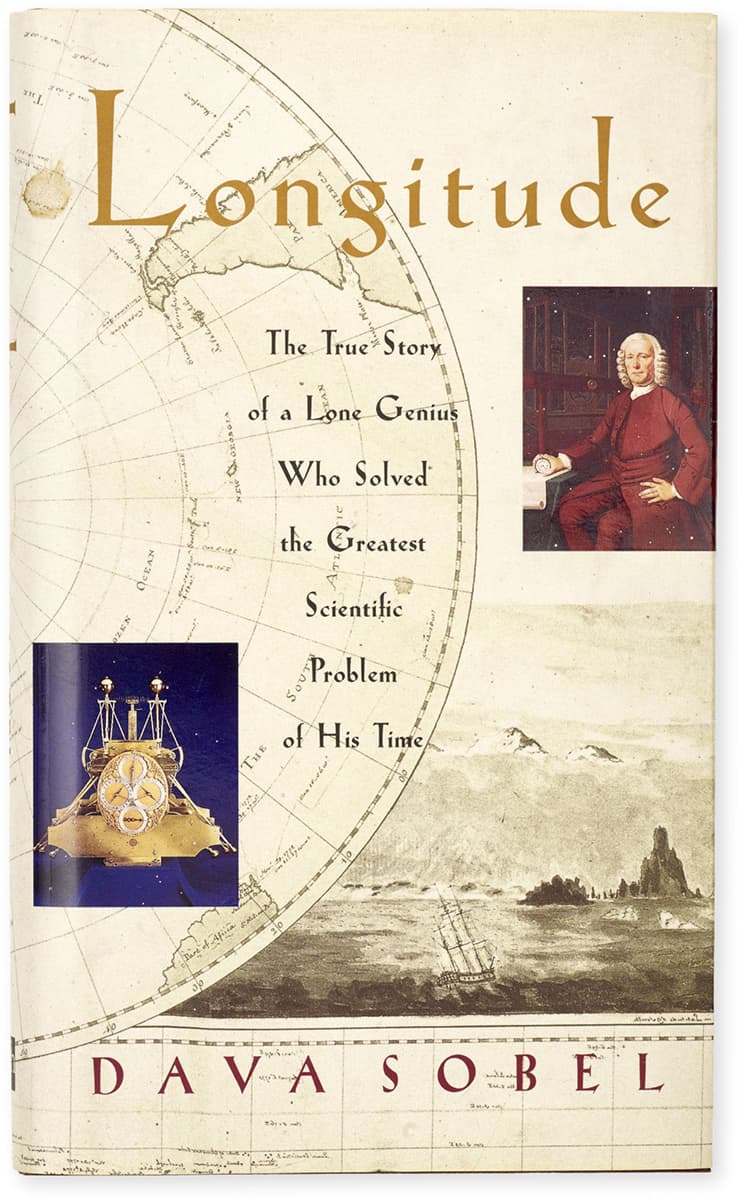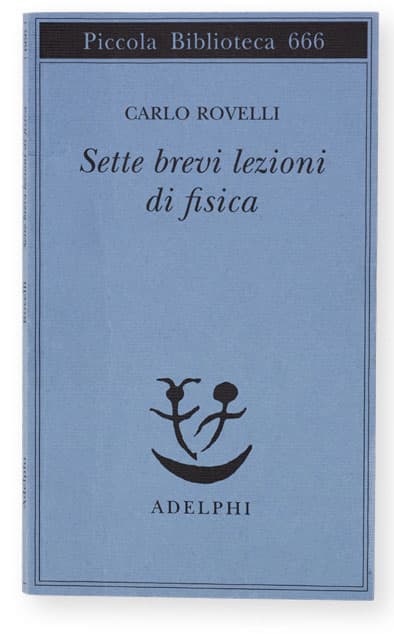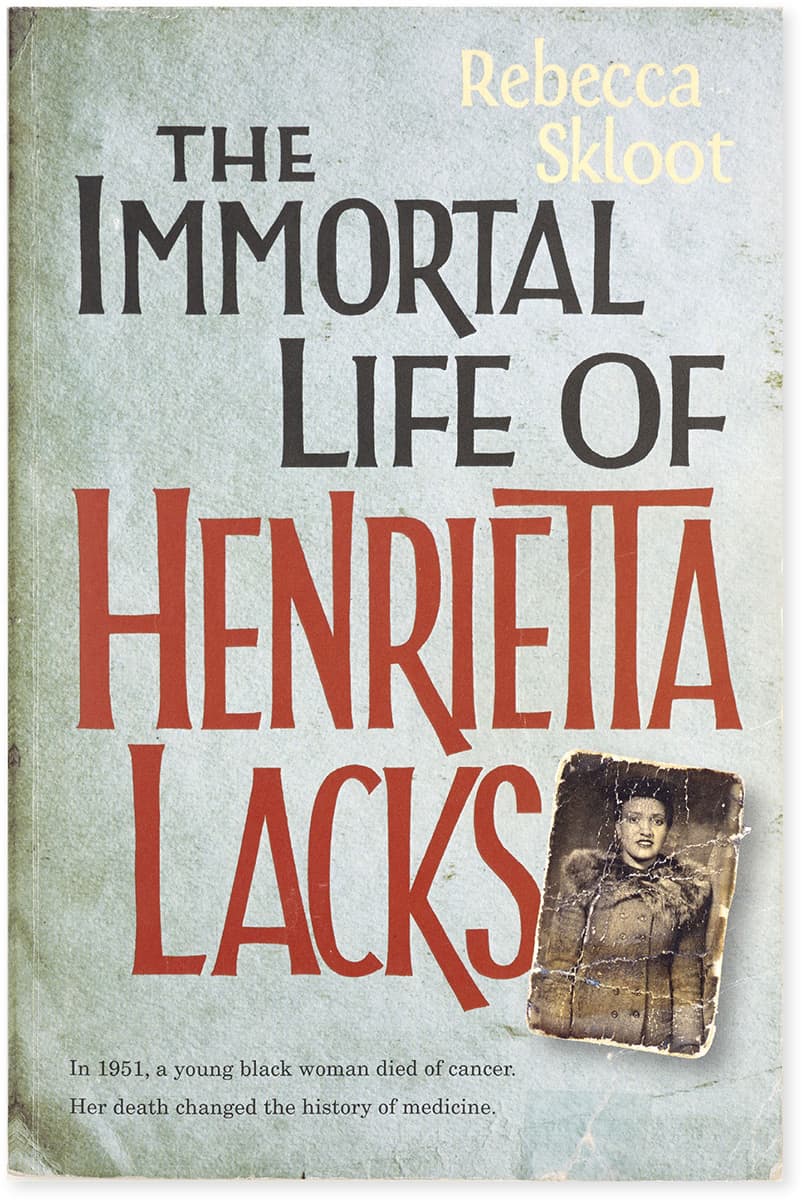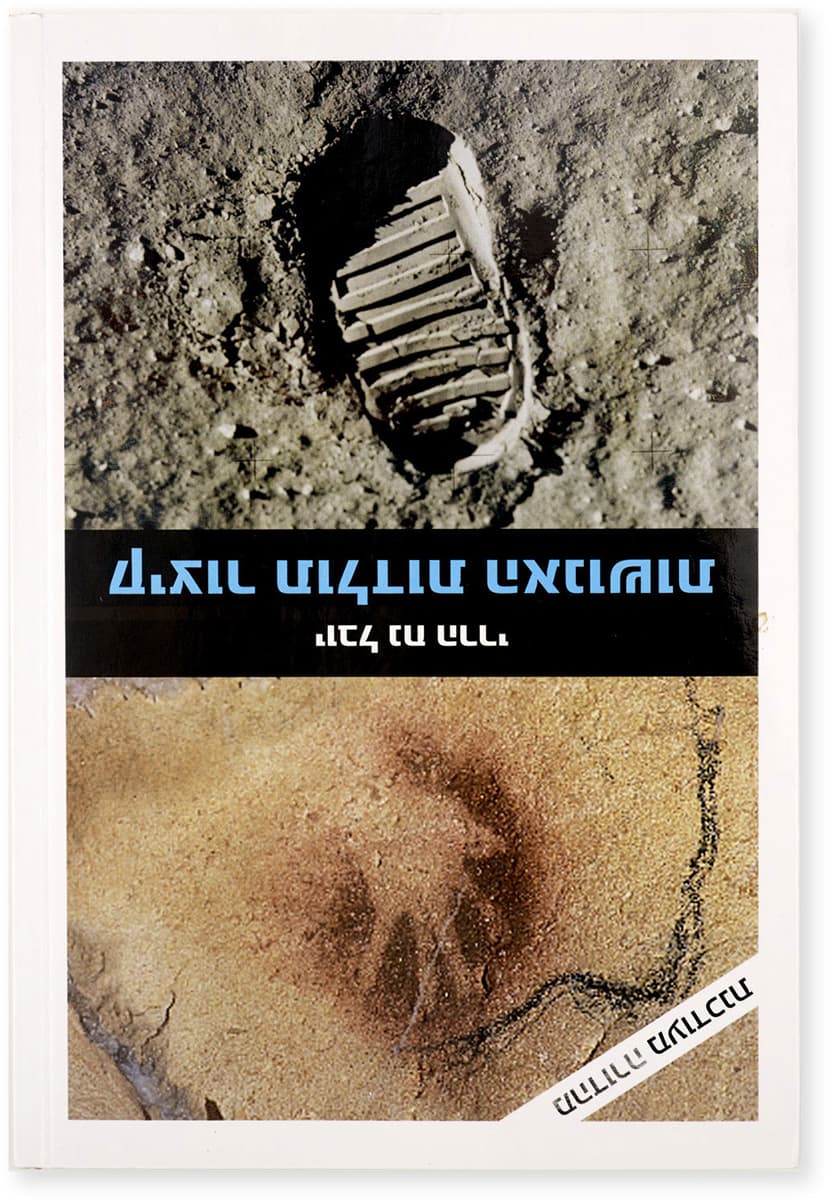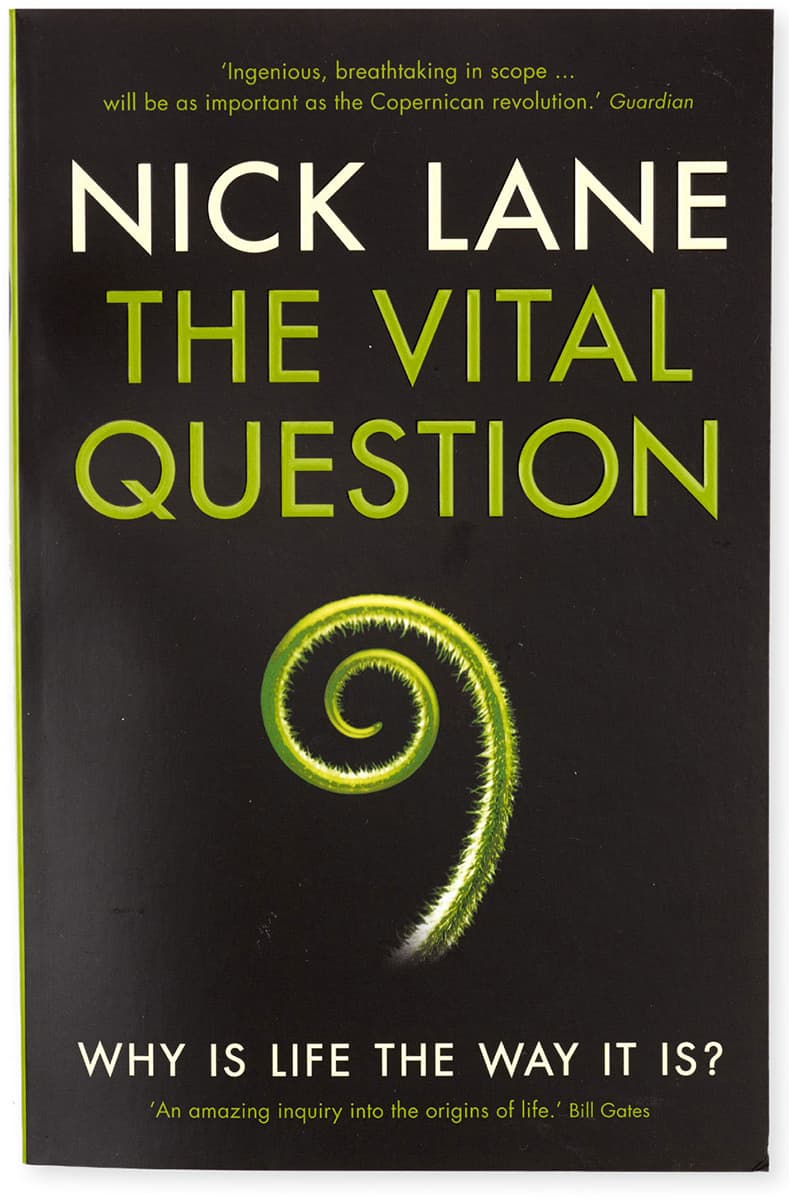5
THE NEXT GENERATION
TRANSFORMING UNDERSTANDING
AS SCIENCE WRITING moved into the 1980s, it continued to evolve. The public’s attitude to science was changing, from reverence to a mix of fascination and scepticism. The importance of science was greater than ever, and the public wanted better to explore the context and subtext of scientific discoveries. Many of the best books written in the period covered by this chapter – from 1980 to the modern day – have been the work of science writers, rather than working scientists. Where the previous chapter closed with a book that seems designed to make its message more obscure, this period has seen accessible science gradually come to the fore. Science books have grown up.
Interpreting quantum physics
The move to making science approachable did not mean, however, that science writing would entirely avoid obscure subjects (or even obscure presentations). Some of the old school were still active, and none more so than rebel physicist, David Bohm. Born in Wilkes-Barre, Pennsylvania in 1917, Bohm specialised in quantum physics. He could have been one of America’s leading scientists, but despite his contribution to the Manhattan Project, his left-wing political views made him a target of Senator McCarthy’s House Un-American Activities Committee. Bohm moved to Brazil in 1951, and later to Israel, before settling in the UK.
For physicists, Bohm’s most important book was his textbook The Special Theory of Relativity from 1965, yet his most original book, and one that reached a more eclectic audience, came later in life. This was Wholeness and the Implicate Order from 1980. The book builds on Bohm’s unusual interpretation of quantum theory to give a mixed physical and philosophical view of the workings of the universe as a whole.
Quantum physics is the only area of science where there is a significant focus on interpretations. The basics mathematics of quantum theory is stunningly precise at predicting the behaviour of electrons and atoms, molecules and photons. Richard Feynman observed that it was so accurate it was like predicting the distance from New York to Los Angeles to the width of a human hair. But the theory says nothing about what actually happens inside a quantum system. The physics is a black box where we put the numbers in, turn the handle and get a correct result out, but with no idea why these results emerge.
Ever since the early days of quantum theory, physicists have come up with interpretations that try to explain what is going on. The original, and still probably most used, is the Copenhagen interpretation, named after the home city of founding quantum physicist Niels Bohr. It says there is nothing but probability before a particle is observed – there is no underlying reality. Often described as ‘shut up and calculate’, this approach did not satisfy everyone. David Bohm picked up on the work of French quantum physicist Louis de Broglie, suggesting that each particle had a real (if unknowable) location, and had an associated ‘pilot wave’ which guided its movement.
The problem with Bohm’s theory, and the reason that it has never been widely accepted, is that it requires everything everywhere to have immediate influence on the rest of the universe. For his interpretation to work, the universe has to be an interconnected whole, transcending the lightspeed limit of Einstein’s special relativity. It was this that led Bohm to write Wholeness and the Implicate Order, which put forward the idea that there are two levels of reality: explicate reality, the level we usually xperience; and implicate reality, which underlies everything and links everything together, and is responsible for still unexplained phenomena such as consciousness. Bohm’s ideas are even harder to penetrate than those of Douglas Hofstadter in Gödel, Escher, Bach (see here) but there is no doubt that this was an influential book, reaching well beyond the physics community.
Bohm’s title does not explore the nature of quantum physics itself, a topic that was relatively infrequently touched on until the following century. Feynman’s book QED (see here), for example, only covered a relatively small subset of the topic. However, English science writer John Gribbin gave quantum physics a new appeal in 1984 with his best-known book, In Search of Schrödinger’s Cat. Like Desmond Morris and Richard Dawkins, Gribbin started his life as a working scientist, but became an extremely prolific science writer, continuing to the present day. The cat in question is the poor hypothetical animal that appeared in the Austrian physicist’s thought experiment back in 1935.

David Bohm
WHOLENESS AND THE IMPLICATE ORDER, ROUTLEDGE & KEAGAN PAUL, 1980
A first edition of Bohm’s title with a cover that makes no concessions to the reader.
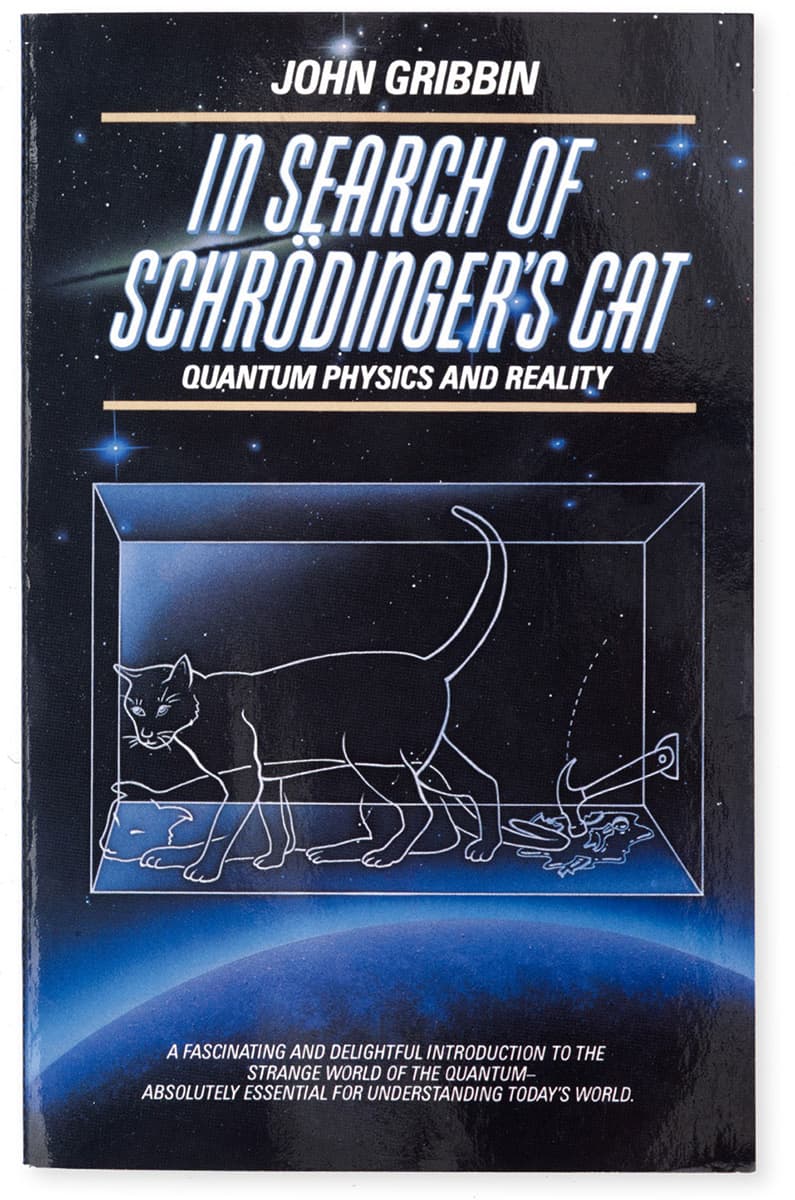
John Gribbin
IN SEARCH OF SCHRÖDINGER’S CAT, BANTAM BOOKS, 1984
Quantum physics had very limited popular exposure before Gribbin’s book.
The idea of Schrödinger’s cat was to highlight the oddity of a concept called superposition. This says that a quantum particle that could be in one of two possible states will not be in either state until observed; instead, it exists purely as probabilities of each possibility. In the case of the cat, Schrödinger envisaged an experiment where a detector released poison gas into a box when a quantum particle decayed. When this happened, the cat in the box would die. But before the particle was observed, it would be in a superposition of both decayed and not-decayed states – meaning that until the box was opened, the cat would be neither dead nor alive.
In practice, this was a throw-away concept that doesn’t deserve the attention that has been given to it – but the image of the dead-or-alive cat proved popular and Gribbin cleverly hangs his book on it, even though he covers far more of quantum physics. Gribbin’s is one of the earlier examples of what might now be considered the standard framework for a popular science book. It explains the science – in this case quantum physics – largely without using mathematics, but with a considerable amount of analogy, and it puts the science into context, giving it a significant amount of human interest by including some history of science too, telling us about the people who developed the theory and how they came up with their ideas. In Search of Schrödinger’s Cat is the archetypal approachable popular science book.
Confusion in the brain
Something that comes through strongly in the influential texts since 1980 is the dominance of two fields: physics and human science. Schrödinger’s Cat was followed up in the next year by a classic human science title, The Man Who Mistook His Wife for a Hat. Written by English neurologist Oliver Sacks, the book plays on our human interest in the suffering of others, exploring the cases of a number of Sacks’ patients.
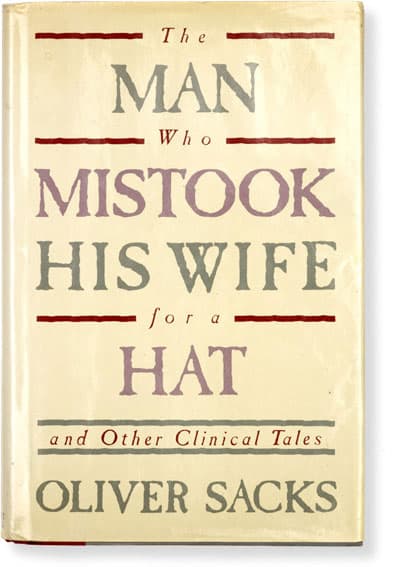
Oliver Sacks
THE MAN WHO MISTOOK HIS WIFE FOR A HAT, SUMMIT BOOKS, 1985
Despite being a collection of unconnected essays, Sacks’ book struck a chord with readers thanks to his storytelling ability.
Unlike most successful science books, this 1985 title is a collection of unconnected essays, each exploring a different case study. The studies cover individuals suffering from a range of conditions, including the visual agnosia of the title story (an inability to visually recognise objects), the inability to remember anything that has happened since the end of the Second World War, and the experience of twin autistic savants. Sacks uses storytelling surprises to keep the reader engaged, such as in his account of the reactions of the inhabitants of a ward for the mentally ill to a televised speech, where the elements that the individuals took from the speech were totally different, informed by their conditions.
There is a danger that a book like this becomes the literary equivalent of a freak show. This was even more of a risk with the 2004 title Mutants by evolutionary biologist Armand Leroi, which showed how we are all genetic mutants, using as examples historical extremes of human mutation who were exhibited and vilified. Leroi manages to avoid the freak-show effect by keeping human development as the focus of the book, rather than the mutants. It’s harder to get away from the individuals in Sacks’ book, because here the disorders themselves are his topic. Even so, Sacks manages to use his case studies to explain aspects of the functioning of the brain without blatant exploitation. The result was a bestselling title that appealed to a much wider public than a normal medical text.
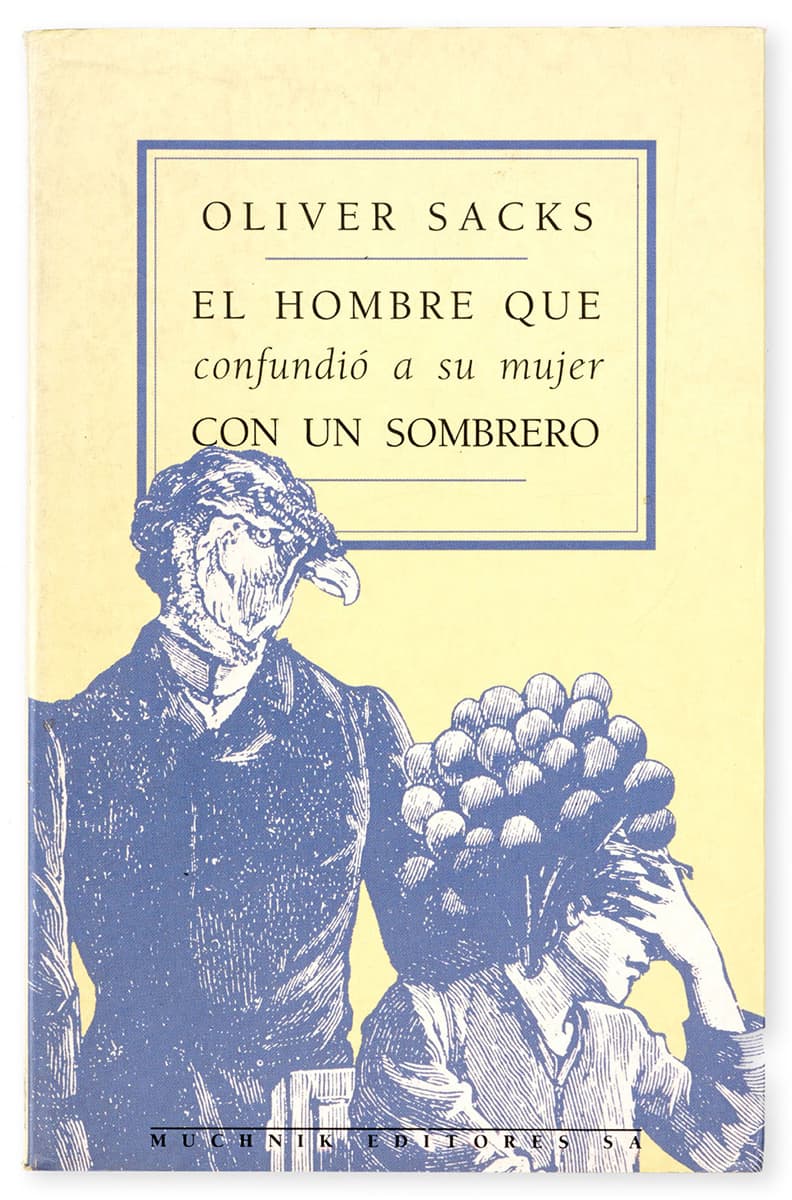
Oliver Sacks
THE MAN WHO MISTOOK HIS WIFE FOR A HAT (EL HOMBRE QUE CONFUDIÓ A SU MUJER CON UN SOMBRERO), 1991
A Spanish edition published by Muchnik Editores.
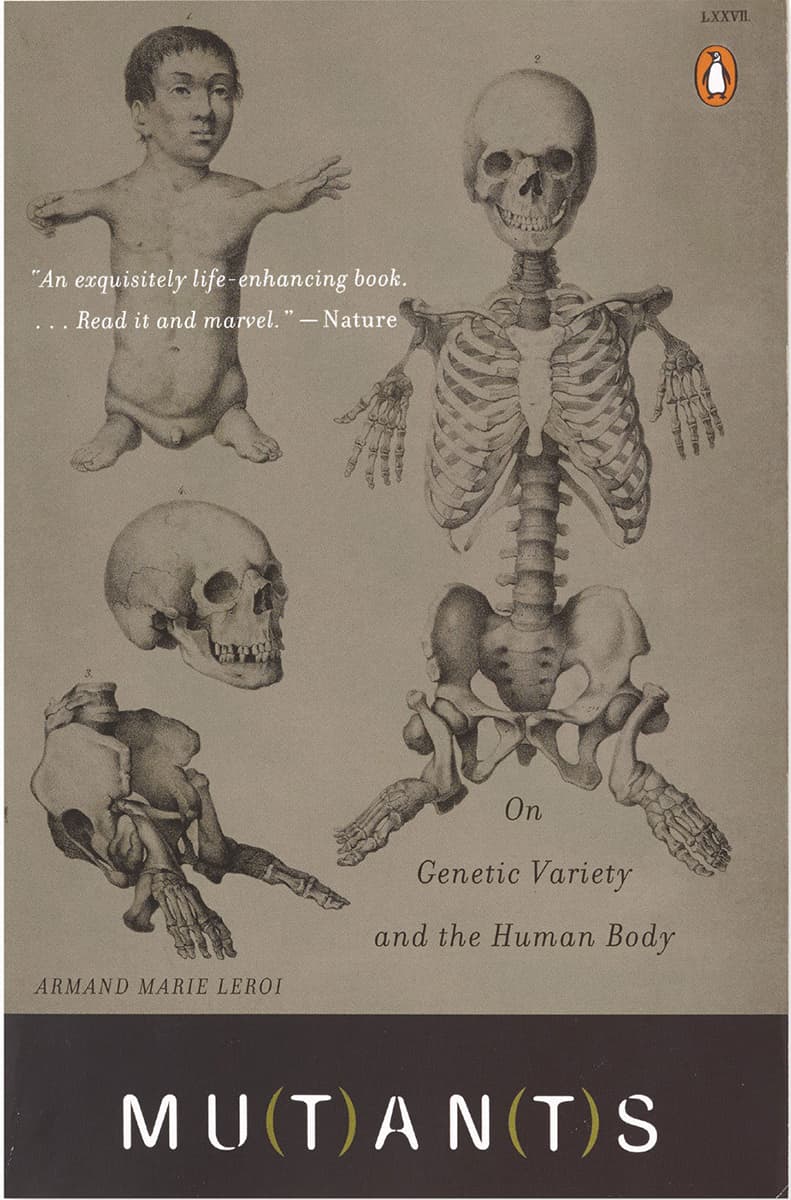
Armand Leroi
MUTANTS, PENGUIN, 2005
A US Penguin edition of the UK original published in 2004 by HarperCollins.
Science stories and scientific legends
As we have seen, the co-discoverer of the structure of DNA, James Watson, wrote a popular book in 1968. The Double Helix (see here) took a story- and biography-driven approach that would come to typify the best American popular science titles, in contrast to European equivalents that tended to be driven more by the science. Typifying this ‘human-interest story’ approach was a book published in 1987 called Chaos: Making a New Science – the first book by a mainstay of US popular science, James Gleick.
James Gleick
CHAOS, VIKING PENGUIN INC., 1987
A dramatic cover suggestive of fractal patterns from the first edition of Gleick’s successful story-driven approach to a mathematical topic.
Born in New York, Gleick remains unusual in popular science circles in having an arts background rather than a science degree. This no doubt contributed to his use of the distinctive story-driven approach seen in the opening of Chaos: ‘The police in the small town of Los Alamos, New Mexico, worried briefly in 1974 about a man seen prowling in the dark, night after night, the red glow of his cigarette floating along the back streets. He would pace for hours, heading nowhere in the starlight that hammers down through the thin air of the mesas.’ It might have been the opening of a noir detective novel. If the staid old ‘authority preaching to the masses’ approach of popular science had been pushed aside by the likes of Watson and Gribbin, it was now totally shattered.
Another impressive aspect of Gleick’s book was that it made popular maths acceptable. Up to this point, mathematics had been a practical subject, either taking the reader through a method and examples, or being an unfortunate adjunct to science that made popular titles harder to read. In Chaos, Gleick showed that, done right, maths could be as appealing as the other sciences. It remains the hardest topic to make accessible, yet Chaos would make it possible for a range of other popular maths books to do well.
Gleick’s topic, the development of chaos theory, was timely. Chaos in mathematical terms is not the inchoate mess implied by the general usage of the word. Chaotic systems obey clear rules. However, interactions between parts of the system are so disruptive that the tiniest change in the way a process starts can have a big influence on its progress. This is why weather forecasting is so difficult. In fact, chaos theory began when American meteorologist Edward Lorenz decided to re-run an early computerised forecast. The process took hours, so rather than start it at the beginning, he used the values from a printout made after the program had run for some while. However, the computer missed a couple of decimal places off the printout compared to the values it used internally, and the tiny fractional change totally altered the forecast.
At the time Gleick wrote the book, chaos theory seemed about to transform the way that mathematics was used in science, and Gleick was able to make it sound impressively important (it’s no surprise that in the movie Jurassic Park, made just a few years after Chaos came out, Jeff Goldblum’s sceptical character Dr Ian Malcolm was an expert in chaos theory). As it happens, that early promise fizzled out. Awareness of the impact of chaotic systems has been hugely important, but the direct applications that Gleick’s book foresaw have not come to pass. Even so, Chaos remains a great read and, crucially, took the development of science writing to the next level.
The following year, a book was published that had a huge impact on the popular science market and would make its author a media star. The book was A Brief History of Time by Stephen Hawking. Interestingly, in contrast to Chaos, the book’s approach is that of an authority speaking from on high – though Hawking softens this by adding a few personal comments and touches (added during repeated edits as the publisher tried to make the book more accessible).
The famous English physicist worked on highly esoteric aspects of black holes and cosmology, yet his personality and his management of his debilitating medical condition won over the public. A Brief History of Time became the bestselling popular science title in modern history, until it was eclipsed 15 years later by Bill Bryson’s A Short History of Nearly Everything (see here). Despite the title, Hawking’s book tells the reader very little about time itself. Instead, it starts with the way that relativity intertwines space and time, then goes on to cover cosmology.
Stephen Hawking
A BRIEF HISTORY OF TIME (DAL BIG BANG AI BUCHI NERI), 1988
The first edition cover of Hawking’s bestseller published by Bantam Press, alongside an Italian translation published by Rizolli in the same year that reverses title and subtitle to make this From the Big Bang to Black Holes.
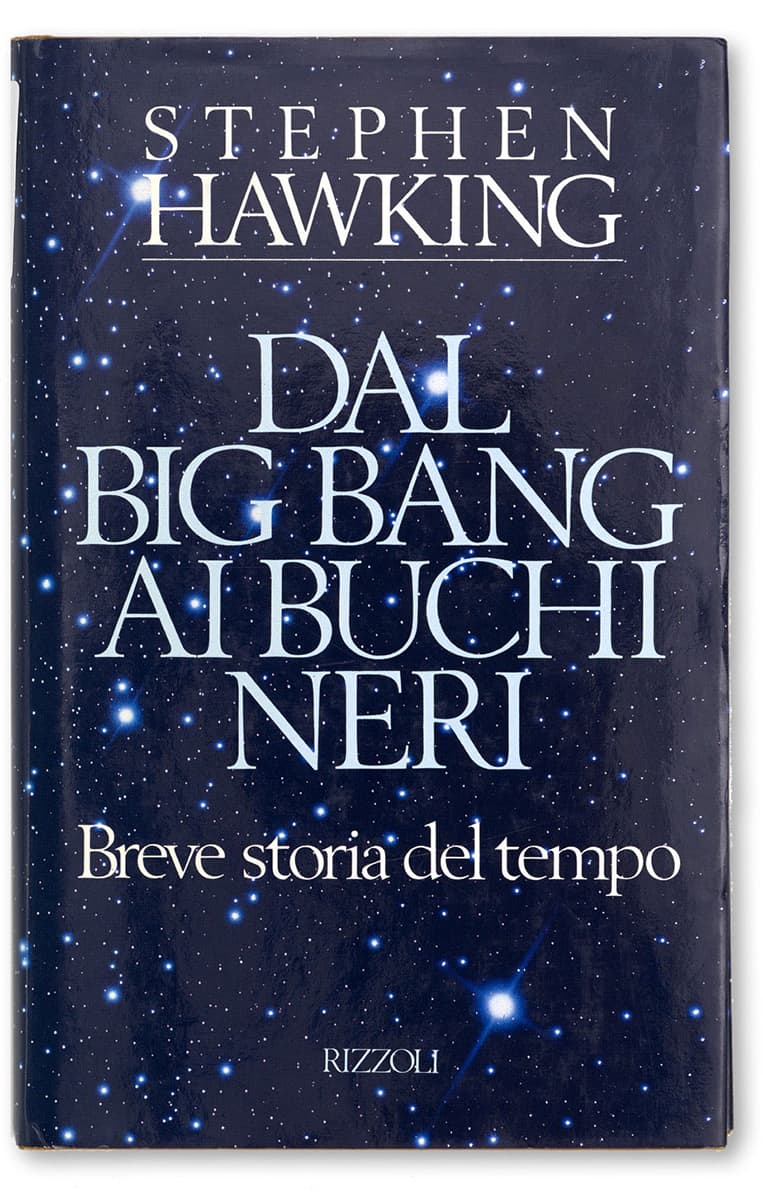
Stephen Hawking
A BRIEF HISTORY OF TIME (EINE KURZE GESCHICHTE DER ZEIT DIE SUCHE NACH DER URKRAFT DES UNIVERSUMS), ROWHOLT, 1988
The first German edition of this popular science classic where the subtitle has become ‘the search for the primal force of the universe’, alongside a photograph of Stephen Hawking from the 1980s.

A Brief History of Time is not a long book, which may make it seem odd that it has such a reputation for being far more frequently bought than read. In reality, many purchasers may well at least have started it, as Hawking eases the reader in gently with a warm story of a scientist (possibly the philosopher Bertrand Russell) giving a lecture on astronomy, only to be told by an old lady in the audience, with shades of Terry Pratchett, that the world was a flat plate on the back of a giant tortoise.
Hawking took note of his publisher’s repeated warning that every equation included halves the number of readers. But the book lacks context and narrative, and I suspect many readers gave up when Hawking got onto the relativistic concept of light cones, which can confuse more than they explain. It feels odd to describe A Brief History as a great science book, given so many readers have given up on it – the essence of a great science book is its ability to communicate science with the desired audience, in which requirement this title clearly fails. However, what Hawking’s book did was to bring popular science to the attention of publishers, impressing them by its sales, and its transformation of the popular science market has enabled far more effective books to published.
The TV effect
It’s arguable that the success of A Brief History also encouraged a short flowering of high-quality science programming on television, which would themselves have spin-off books. There has always been a difficult balance in presenting television science. Early attempts were, like early popular science books, very much about an authority lecturing the audience. But television also produced lowest-common-denominator shows, which spent most of their time on pretty images and hand-waving statements with little coverage of the science itself.
The exception to this has been natural history, which lends itself to effective visual presentation more than any other scientific topic. As a result, for example, of the success of British naturalist and broadcaster David Attenborough’s many series, such as Life on Earth and Blue Planet, we have seen a number of visually pleasing books. It’s arguable, though, that these titles – large format and heavily illustrated – aren’t true science books. Where a science book covers far more, in much greater depth, than a documentary, these ‘book of the series’ titles simply follow the structure of the show and illustrate the episodes in it. And because these programmes don’t usually have the sophistication of scripting of Bronowski’s The Ascent of Man (see here), the result is limited as science writing.
Natural history apart, only a handful of television series have had much literary impact. Carl Sagan’s 1980 Cosmos series in the US produced a very popular spin-off book, though its history of science was distinctly weak, claiming that nothing happened between the fifth and the fifteenth centuries, which is clearly untrue. Meanwhile, in the years following the publication of A Brief History of Time, the BBC’s Horizon programme had one major written success. This was a spin-off from the show The Proof, presented by English science writer Simon Singh. Despite using the same research as the television show, Singh’s 1997 book on the same subject, Fermat’s Last Theorem, was excellent, because it acted as a standalone title in its own right, rather than as a coffee-table ‘book of the series’, containing far more than the documentary ever could.
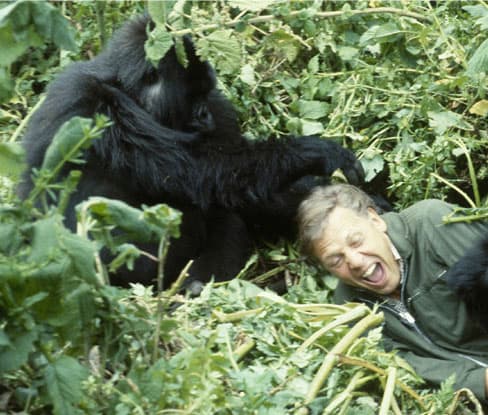
DAVID ATTENBOROUGH WITH MOUNTAIN GORILLAS, 1979
A scene in Rwanda, on location for the BBC television series Life on Earth.

David Attenborough
LIFE ON EARTH, COLLINS/BBC BOOKS, 1991
Spin-off title from the popular television series.
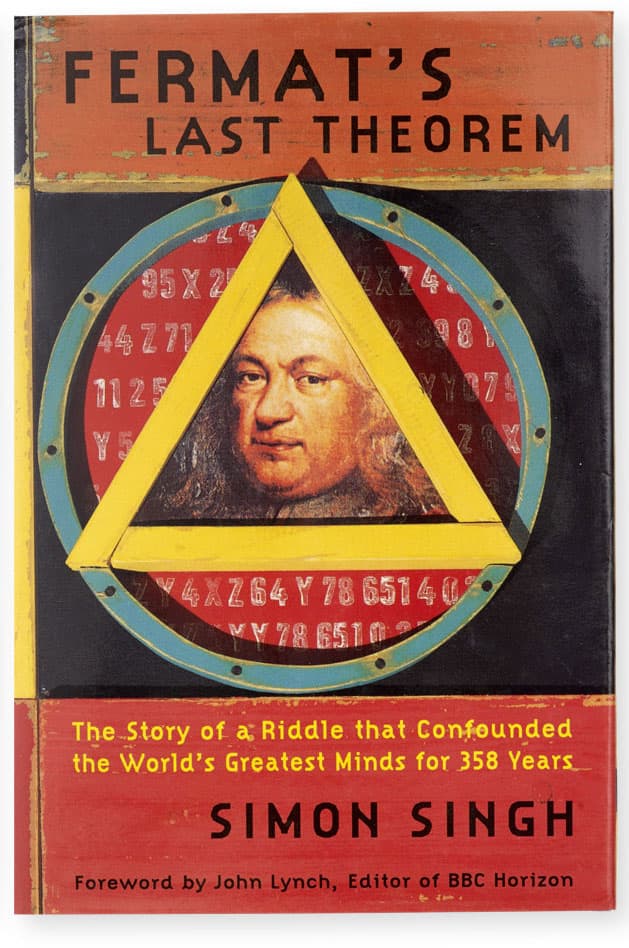
Simon Singh
FERMAT’S LAST THEOREM (LE DERNIER THÉORÈME DE FERMAT)
The first edition of Singh’s excellent 1997 mathematical title published by Fourth Estate, alongside a 1998 French translation published by JC Lattès.

Singh achieves something of a miracle with this title. Not only is Fermat’s Last Theorem about the frequently inaccessible topic of maths, it covers a particularly obscure aspect of it. Yet by providing an effective narrative, Singh makes the topic fascinating – and as a result he had the UK’s first ever number-one non-fiction bestseller with a maths title. The theorem in question shows that it isn’t possible to have three positive integers, each cubed or raised to (the same) greater power, where adding two together made the third. Not earth-shattering mathematics. But what has intrigued mathematicians since the seventeenth century is the way that the theorem was teasingly announced.
In 1637, French amateur mathematician Pierre de Fermat scribbled something in the margin of a copy of Arithmetica by the third-century Greek philosopher Diophantus (see here), which contained an early version of algebra. Diophantus was discussing a similar (solved) problem applied to the squares of numbers. Fermat noted that he had proved it was impossible to do this for cubes and higher powers. ‘I have discovered a truly marvellous proof of this, which this margin is too narrow to contain’, he noted.
Ever since, attempts have been made to find Fermat’s ‘proof’, strictly a conjecture (as he gave no proof), but universally referred to as Fermat’s last theorem. Remarkably, it was not until 1994 that the theorem was actually proved by English mathematician Andrew Wiles, using 100-plus pages of mathematics that were far beyond anything Fermat would have understood. (It is generally thought that Fermat was, at best, over-confident.) In his book, Singh takes this idea and builds it into a satisfying story, mixing the history of the concepts involved, from the earliest days of algebra to Wiles’s epic solution.
Neil deGrasse Tyson
ASTROPHYSICS FOR PEOPLE IN A HURRY, W.W. NORTON & COMPANY. 2017
Popularity from presenting television shows helped Tyson, an astronomer, to gain a wider audience for his explanation of the basics of astrophysics.
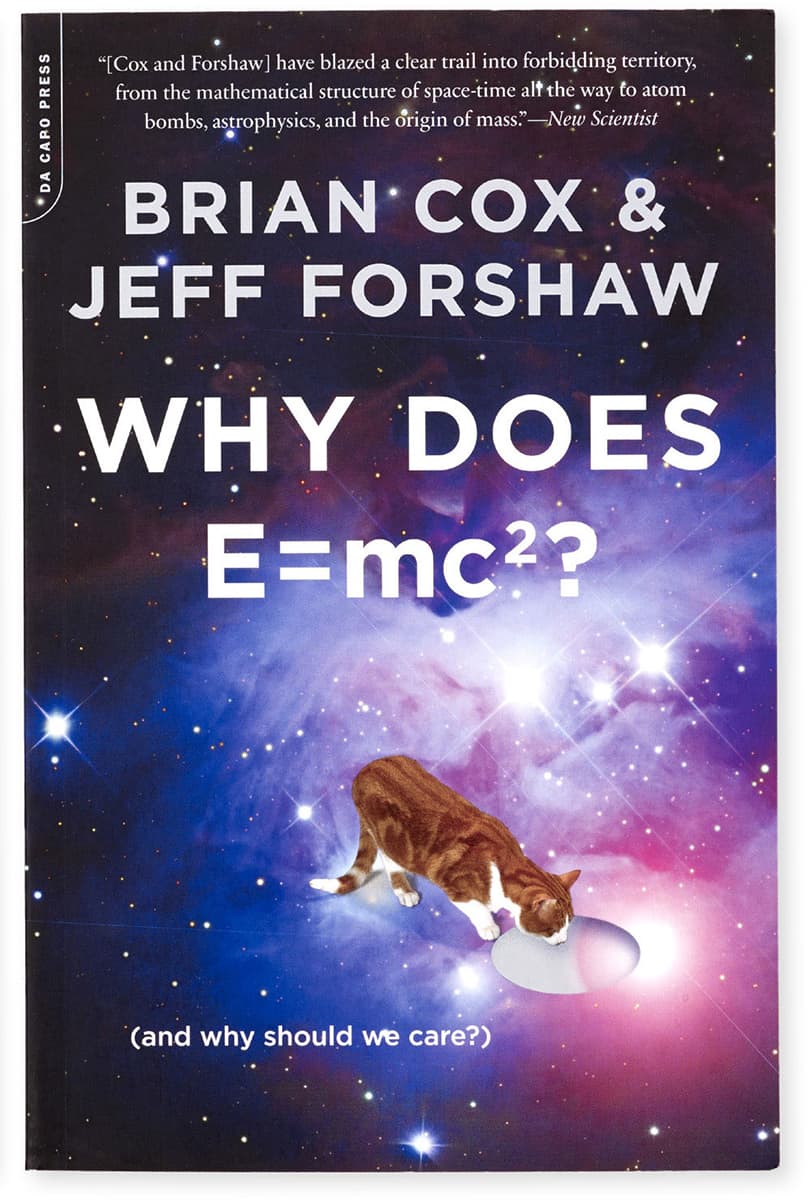
Brian Cox and Jeff Forshaw
WHY DOES E=MC2?, DA CAPO PRESS, 2010
Although Cox had significant success with spin-off books from his television shows, his best titles have been standalone books going into far more depth, such as this one co-authored by Forshaw.
While we’re in the area of books linked to television science shows, two notable, more recent ventures include the reboot of Cosmos, presented by American astronomer Neil de Grasse Tyson, and a number of UK science series presented by physicist Brian Cox. Although these inevitably spawned associated coffee-table books, far more interesting were the titles that both presenters put out in their own right on the back of their television exposure. For Tyson, the best example was the 2017 Astrophysics for People in a Hurry, while Cox has co-authored a number of titles with physicist Jeff Forshaw, notably Why Does E=mc2? from 2010 and The Quantum Universe from 2012.
Where Tyson continues to write at the level of the television show, but adds more content, Cox takes the bolder step of writing books that require considerable effort to read. As a result, they really reward the reader by giving more depth to the physics than would normally be found in such a title. In both cases, though, what we have here are examples of modern science books by scientists – not covering their own tiny specialist area in technical detail as a scientist of a previous generation might have done, but introducing the general reader to the broader field.
Human stories and the innocent abroad
Science and technology go hand in hand, never more so than when determining longitude – the east-west position of a location on the Earth – a process that was inextricably tied to advances in astronomical science. This became increasingly important from the fifteenth century as long sea journeys were made. In essence, given that the position of the Sun at a particular time in the sky indicates the longitude of the observer, the essential requirement was to accurately fix the time, compared with a known location.
Astronomical attempts to solve the problem – an important enough puzzle that the British government in 1714 offered a significant reward for its solution – used observations such as the positions of the moons of Jupiter as celestial timepieces. However, the ultimate effective approach was to devise a clock that could survive long sea voyages and still keep accurate time. This was not easy, as most accurate clocks of the period used pendulums, useless on a rocking ship.
Describing the solution to this problem was Longitude, published in 1995 by American science writer Dava Sobel. Sobel has specialised in titles exploring the history of science through the viewpoint of an individual character. (Her other best-known title, Galileo’s Daughter from 1999, uses Galileo’s relationship with his illegitimate daughter Virginia to explore his work.) Longitude tells the story of English clockmaker John Harrison, his attempts to beat the longitude challenge, and his fight with the authorities reluctant to pay him his due.
Like the best popular science, Sobel’s work gives plenty of information about the problem of measuring longitude and the methods of discovering it, but does so in a way that leads the reader along using the story of Harrison’s life and work. Harrison was no overnight success – it took him many years to perfect his shipboard chronometer, and even when he did so, the British Board of Longitude was reluctant to award him the £20,000 prize, which the accuracy of his clocks should have won. This was a huge amount of money at the time – the equivalent in 2018 of around £2.8 million ($3.5 million) in purchasing power, or a remarkable £35.5 million ($45 million) in terms of labour value (based on what the average wage of the time would buy).
John Harrison
THE MOVEMENT OF H.4, INK ON PAPER, CA. 1760–72
The movement of H.4, one of the series of longitude chronometers designed and drawn by John Harrison, described in Dava Sobel’s Longitude.
Dava Sobel
LONGITUDE, FOURTH ESTATE, 1996
The first UK edition of Sobel’s 1995 title on Harrison’s struggles to win the Longitude Prize, described on the cover as ‘the greatest scientific problem of his time’.
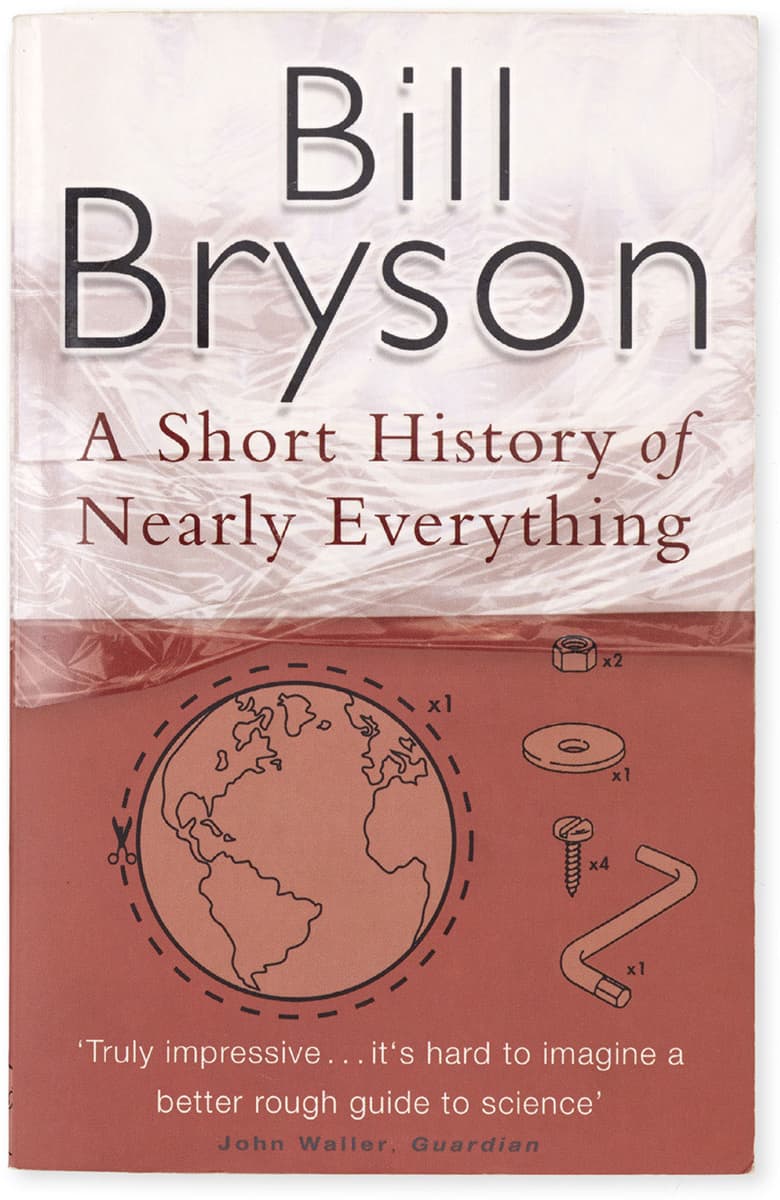
Bill Bryson
A SHORT HISTORY OF NEARLY EVERYTHING, BLACK SWAN, 2004
First published in 2003, this accessible guide to science is now the highest-selling popular science book in the twenty-first century.
Harrison eventually got the majority of the prize money from the Board, which was topped up when he was 80 by the British parliament after Harrison petitioned them at the suggestion of King George III. What Sobel demonstrates is the importance of context for the general reader – she brings the science and technology alive through the circumstances of the lives of those involved in its development.
This approach is fine when looking back at how a scientific or technological breakthrough was made in the past, and such historical context is also very important when explaining the latest scientific breakthroughs. But with new developments, it can also help if the scientists involved in the discovery are interviewed in the process of writing the book. The most extreme example of this approach is Bill Bryson’s A Short History of Nearly Everything from 2003, in which Bryson takes on the role of the ignorant but curious everyman, interviewing a string of scientists to discover more about different topics. The result was the bestselling modern science book yet to be published.
Three physics heavyweights
The success of Bryson’s book did not mean that such lightweight overviews would come to dominate the field. Entirely different in almost every regard was Lee Smolin’s important physics title from 2006, The Trouble with Physics. Smolin is an American theoretical physicist regarded by some as a maverick. Not only is the book written by an expert, it focuses on one specific area of science – string theory – and provides an analysis which, while approachable by the general reader, does not pull any punches.
Smolin gives the reader a good summary of string theory, the leading attempt to unify the two central but incompatible aspects of physics, quantum theory and the general theory of relativity. However, the power of his book is in communicating to the general reader the worrying aspects and flaws of string theory. All too often, science books for the public smooth over problems and present as fact what is no more than hypothesis. But Smolin opens up a can of worms that the physics community would have preferred to keep hidden. Smolin’s was not the only book to do this – another physicist, Peter Woit, produced a more technical book on the same subject with the catchy title Not Even Wrong in the same year – but Smolin’s has had the bigger impact because of its accessibility.
Smolin shows how the physics community has been beguiled by the elegance of string theory. Since the 1980s, many physicists have built their careers on this theory, and so have been highly reluctant to consider any other possibility. And yet the theory makes no useful predictions that can be tested. Smolin shows how much the focus on string theory has suppressed original thinkers and prevented the development of alternative theories.
Equally meaty in its contribution to an understanding of science, but focusing more on cosmology, was From Eternity to Here by American physicist Sean Carroll, published in 2010. This was, in many ways, what Hawking’s A Brief History of Time should have been for its title to be accurate. As we have seen, one thing that Hawking’s book did not help with, frustratingly, was the nature of time itself. Carroll does this for us in a book that goes into considerably more depth than Hawking’s, dealing with aspects of thermodynamics, relativity and quantum theory, yet managing to be significantly more comprehensible.
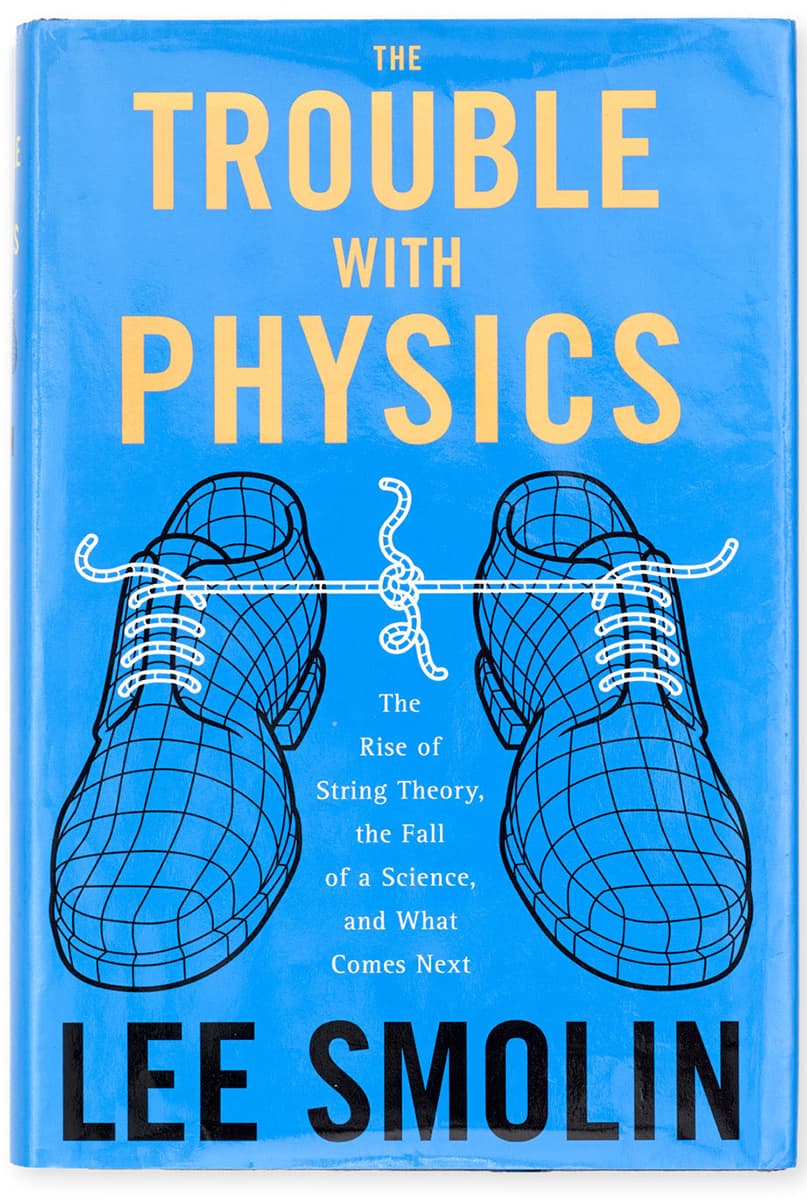
Lee Smolin
THE TROUBLE WITH PHYSICS, HOUGHTON MIFFLIN COMPANY, 2006
Smolin’s book takes on the underlying problems of the influential string theory in physics.
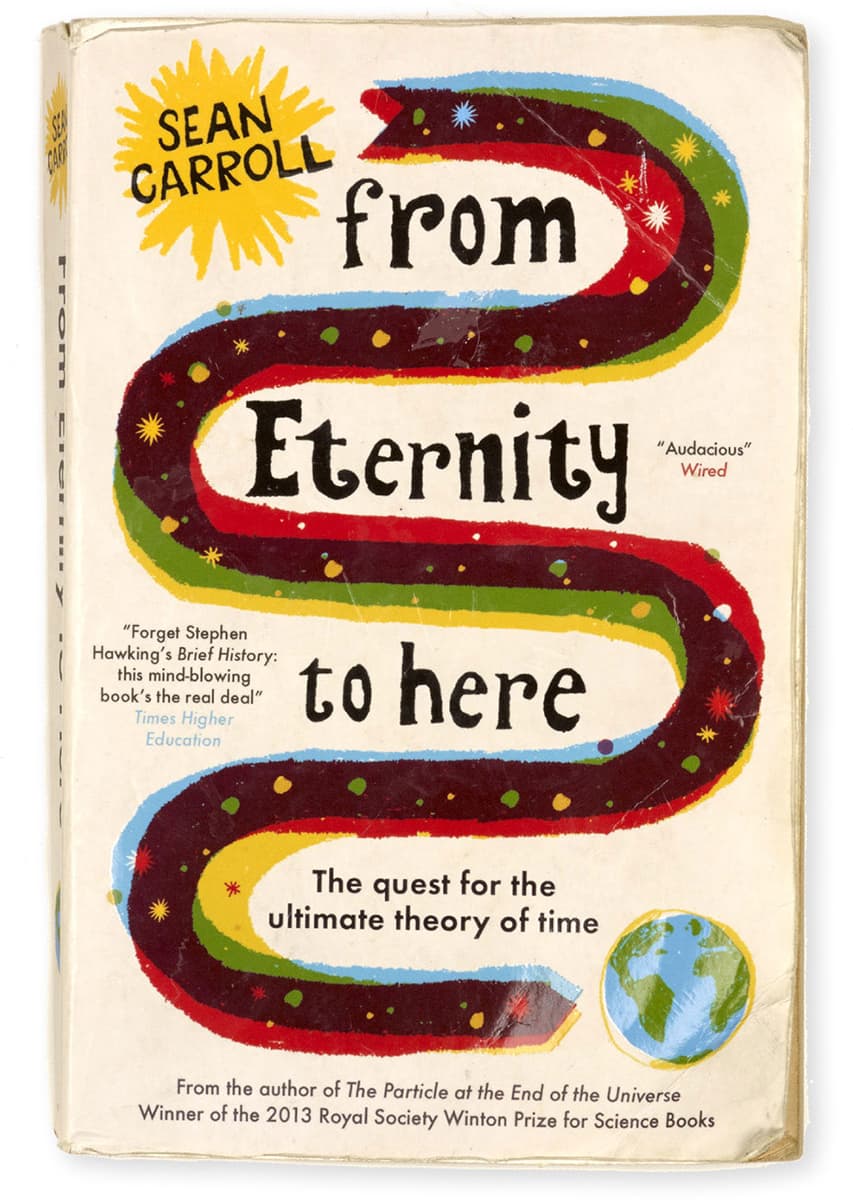
Sean Carroll
FROM ETERNITY TO HERE, ONEWORLD PUBLICATIONS, 2015
First published in 2010, Sean Carroll’s first popular title gives a lucid exploration of the physicist’s view of time.
That the public has an appetite for science if it is presented right was demonstrated impressively in 2014 with the reception of another physics book, also written by a physicist, Carlo Rovelli’s Sette brevi lezioni di fisica (Seven Brief Lessons in Physics). Hugely popular in Italy, Rovelli’s book was one of the very few modern science books written in a language other than English that has gone on to be a worldwide bestseller. It is easy to see why Rovelli’s book became such a breakout success. It is very short, made up of seven essays stitched together and has spread the word about physics to a wide audience.
There seem to be three reasons for the book’s success. While Rovelli does not do much in terms of bringing in the stories of those involved in science, he gives the book a human touch that is reminiscent of works like Erasmus Darwin’s The Botanic Garden (see here). Rovelli makes use of a highly poetic prose style and imbues the text with his own personality. Secondly, the shortness of the book itself can be seen as a benefit for those who find science titles hard going. And finally, the presentation of the book is expensive and sophisticated.
Carlo Rovelli
SETTE BREVI LEZIONI DI FISICA (SEVEN BRIEF LESSONS IN PHYSICS)
The original Italian edition (above) published in 2014 by Adelphi Edizione, alongside the elegant English translation (right) published by Allen Lane in 2015.

Like Carroll and Smolin, Rovelli knows his topic well. An active physicist, he works in one of the most dramatic areas of the field, the attempt to develop a theory of quantum gravity. Since Einstein, the two main aspects of physics have been quantum physics (the physics of the very small, which determines how almost everything we directly experience works) and the general theory of relativity (the physics behind gravity). Although gravity influences everything, it is such a relatively weak force (billions of billions times weaker than electromagnetism) that its main effect is on big things, such as stars and galaxies.
Although both theories are very successful, they are not compatible. They cannot be brought together. This is because gravity is not quantised – it doesn’t deal with the universe in terms of small discrete chunks the way quantum theory does. So ever since the 1930s, attempts have been made to come up with a theory of gravity that is quantised and can be unified with the rest of quantum physics. The leading contender for this is string theory which, as we have seen, is still worked on by many physicists. But as Smolin showed, string theory may never provide a useful scientific structure. However, there are alternative theories.
The leading competitor is currently loop quantum gravity – and it is this field that Rovelli works in. In Sette brevi lezioni, Rovelli gives a series of sketches of key developments in, for example, cosmology and quantum gravity, but he gives a distorted view of the importance of loop quantum gravity. This theory may indeed come to supplant string theory, but as yet it isn’t as well supported. The benefit of this kind of book is likely to be that some readers will be inspired to get hold of more in-depth titles and begin to appreciate science more.
Getting the topic right
Making more people aware of science and technology, given the impact of both on our lives, is crucial. This is why it’s heartening that in Germany the numbers two and three slots for the most successful non-fiction books published between 2005 and 2015 went to titles by Eckart von Hirschhausen, a German medical doctor and television presenter. Most notable of the two was Die Leber wächst mit ihren Aufgaben (The Liver Grows with its Tasks), which addresses quirky scientific questions from the influence of acupuncture on cars (explaining the placebo effect) to the way that holes in cheese make you fat.
As we have seen, books like Hirschhausen’s focusing on human science, along with those that cover physics and cosmology, have dominated the field of science book writing. Other areas of science have been relatively neglected. It’s interesting to speculate why, for example, chemistry has had very little science writing dedicated to it.
A senior editor at one of the UK’s leading science publishers, Oxford University Press, suggested that it can be hard for chemistry titles to appeal to the public. Jeremy Lewis commented in an interview with the author: ‘I do think chemistry is under-represented in popular science. When you go to the bookstore, the small science section usually has an even smaller chemistry shelf. I think chemistry tends to just fly more under the radar when there are “sexier” breakthroughs in disciplines like physics and biology – topics such as quantum theory and gene editing.’ According to research undertaken in 2015 for the Royal Society of Chemistry report Public Attitudes to Chemistry, ‘People struggle to imagine how chemistry affects their everyday lives and regard chemists as lacking in agency: they do not recognize how chemists are involved in the end product of their own work.’
It seems that unless a popular science book is particularly well written, it needs to either appeal to personal interest (for example, health or psychology) or to be about something fundamental and dramatic, as is usually the case with physics and cosmology. It might seem that maths doesn’t fit this general rule, but even this relatively inaccessible topic can be popular when it mixes stories of the peculiarities of mathematicians with the fundamental oddities of mathematics. The personal element is obviously there, for example, in Fermat’s Last Theorem, in its description of Andrew Wiles’s work. It was also important in the success of my own bestselling maths book from 2003, A Brief History of Infinity, which has a topic – infinity – that naturally engages curiosity, but also focuses on the mathematicians involved in developing our ideas of infinity.
Immortal lives
However, it is biology (mostly human) and physics that continue to dominate more recent influential titles. A significant example is Rebecca Skloot’s 2010 The Immortal Life of Henrietta Lacks. Skloot is an American science writer whose medical-themed titles make use of strong storytelling to bring science to the public. The intriguing-sounding title refers to a cervical cancer patient, Henrietta Lacks, who died in 1951. Cells taken from Lacks’ tumour were used to set up an important medical research tool known as an immortal cell line.
Usually, our cells cannot split and form new cells indefinitely, as they have built-in controls that track the number of splits that have occurred using a system called telomeres, which operate rather like a reel of tickets: the telomeres shorten as the cells divide and eventually kill their ability to do so. But in some cancer cells this restriction is permanently removed. Lacks’ cells were the first such immortal cell line to be created, making them hugely important in the history of cellular medicine. The cells, known as HeLa, have been used to research both cancer and AIDS and are still going strong. Over 20 tonnes of Lacks’ cells have now been grown.
What made Skloot’s book (which has sold well over a million copies) so popular was the human interest. She covered Lacks’ life, and the shock to her family, who did not discover the existence of the HeLa cell line until the 1970s. This did not prevent Skloot from also exploring the life and work of the scientists involved and the importance of the work for medical science, but the book emphasises once more the benefit of bringing humanity into the kind of science book that has dominated the field in the last 100 years – a book that helps the general public discover and engage with science.
Rebecca Skloot
THE IMMORTAL LIFE OF HENRIETTA LACKS, 2010
An Australian first edition published by Picador (left) and an American edition by Crown Publishers above a scanning electron micrograph of HeLa cancer cells derived from the sample taken from Lacks in 1951.


A small example of the significance of the HeLa line can be seen in Professor Mark Pallen’s engaging 2018 book, The Last Days of Smallpox, which tells the story of the eradication of the smallpox disease and the circumstances of an outbreak in Birmingham, England, after its eradication. The book notes that the virus samples taken from the carrier in this outbreak showed ‘unusual behaviour when grown on layers of cultured human cells known as HeLa cells’. Henrietta Lacks’ story continued to have resonance in a disease outbreak on a different continent.
Origin stories
As we have seen, science writing has tended to be dominated by English-language titles, which end up translated into other languages – English is now the international language of science, with the vast majority of important scientific papers published in English. Only occasionally does a science book published first in another language make it into English. Perhaps the most unusual example of this is  itsur Toldot Ha-enoshut (A Brief History of Mankind, titled Sapiens in English), published in Hebrew in 2011 by Yuval Noah Harari.
itsur Toldot Ha-enoshut (A Brief History of Mankind, titled Sapiens in English), published in Hebrew in 2011 by Yuval Noah Harari.
Harari is anything but a typical popular science author – as a historian he has no science background. His field comes through more strongly in Sapiens than in his follow-up books, which stray even further from his area of expertise. In Sapiens, he effectively gives a history of the entirety of human existence, but with a genetic context that makes it clear this is intended to be popular science. Harari’s follow-up title, The History of Tomorrow (published in English as Homo Deus) attempts futurology, the always difficult and rarely consistently scientific attempt to predict the future. These books have been international successes, but in the history of science writing they are more significant for their unusual progression from a second language into English than for their content, as the science in these books is widely considered weak by professionals in the field.
A useful contrast, delivering high-quality science, is English biologist Nick Lane’s impressive title on the origins of life, The Vital Question, published in 2015. What Lane does so well here is to make it clear just how complex the cellular machinery is inside organisms with complex cells (like us). Perhaps even more impressively, Lane takes on the biggest biological question of them all: how life started.
Until recently it had been thought that life started in a primeval soup of organic material, perhaps spurred on by the energy of lightning strikes. However, Lane shows how this approach is incompatible with what we now know of the conditions on the early Earth and puts forward an alternative theory, based primarily on water and carbon dioxide. He also explores the way in which getting from simple cells to complex cells is as much a leap as getting started in the first place. Both steps appear to have happened only once, perhaps making life a much rarer phenomenon in the universe than is often thought.
If Lane gives us our best modern answer to where life came from, a 2018 title from English chemist Peter Atkins took things even further by trying to explain how the universe as a whole came into being. Conjuring the Universe is a slim volume, but takes on a mind-bending aspect of science as Atkins explores how it is possible to create a whole universe from scratch.
Noah Harari
KITSUR TOLDOT HA-ENOSHUT (A BRIEF HISTORY OF HUMANKIND)
First pubished in 2011 by DVIR, this is the 2013 updated edition alongside the 2014 English translation published by Vintage.
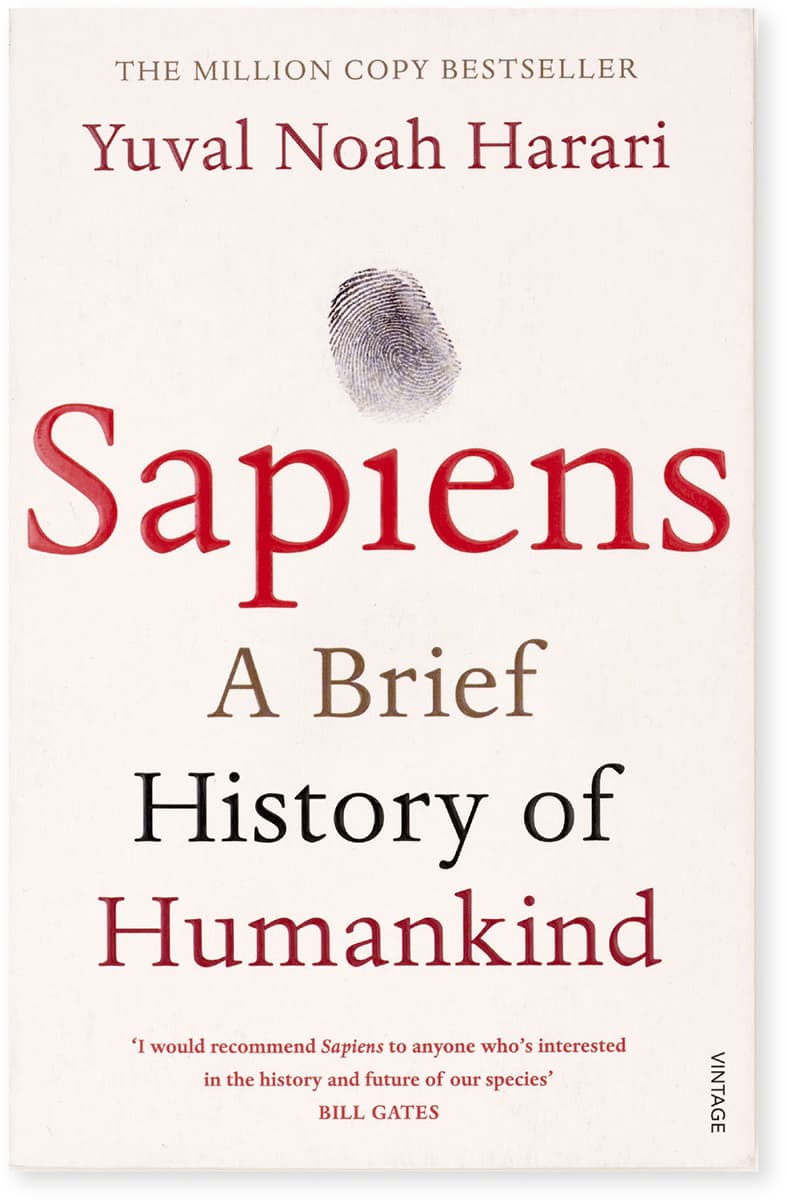
If we imagine the universe starting from nothing much at all, Atkins shows how many of the basic laws of physics emerge from what he describes as indolence and anarchy. The first of these is shorthand for the principle of least action, which says that the universe takes the easiest route in terms of use of energy and so on. Throw in the mathematics of symmetry devised by one of the world’s greatest female mathematicians, Emmy Noether, and Atkins is able to deduce many of the basic principles of physics with a mellifluous writing style that makes it easy to go along with his arguments.
Atkins also goes further to suggest that some of the familiar constants of nature don’t really exist. For example, the speed of light is one of the most important constants, with an exact value of 299,792,458 metres per second. (It’s exact because the metre is defined from this value.) But Atkins points out that the apparent constant is simply a matter of our choice of units – if, as it’s perfectly possible to do, we render such a constant in its most ‘pure’ unitless state, it effectively vanishes away. All in all, this book stirs up the reader’s ideas of what the fundamentals of the universe involve.
Nick Lane
THE VITAL QUESTION, PROFILE BOOKS, 2016
The paperback edition from Lane’s book on the origins of life, first published in hardback in 2015.
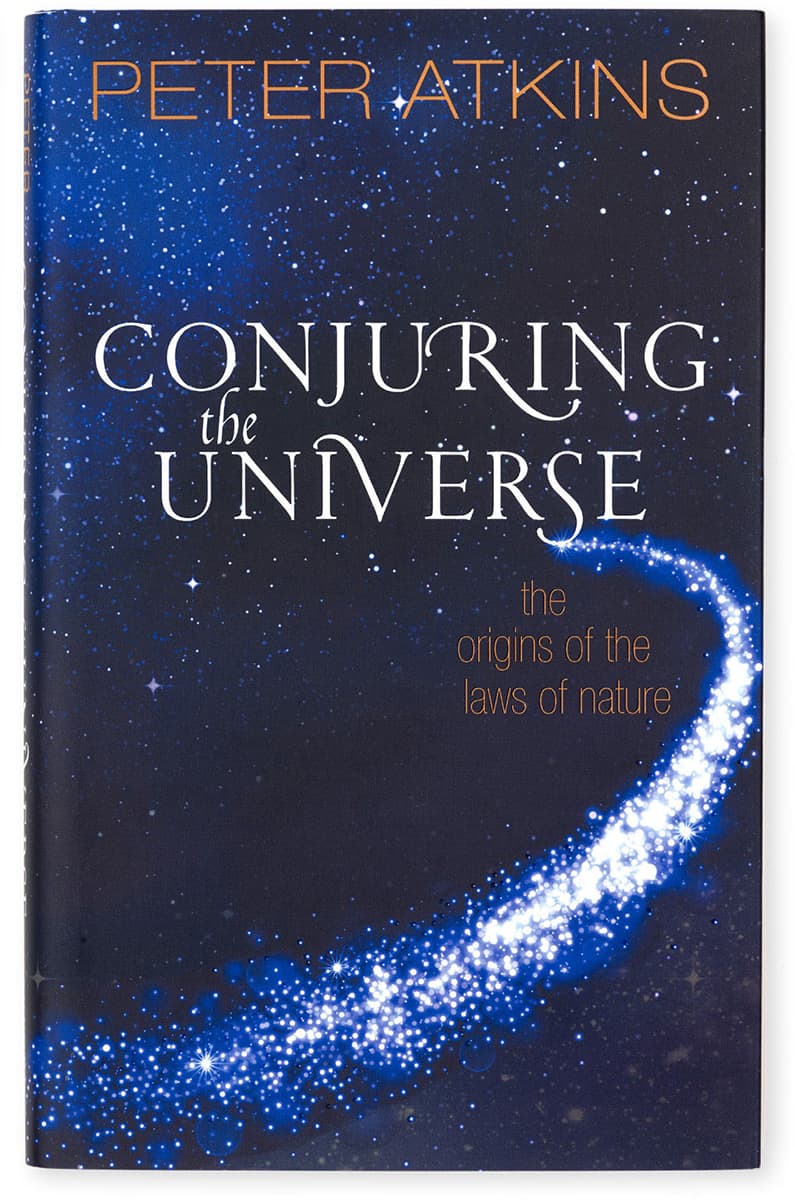
Peter Atkins
CONJURING THE UNIVERSE, OXFORD UNIVERSITY PRESS, 2018
A surprisingly concise exploration of the origins of the universe.
Driving science forward
Although the majority of the authors included in this chapter are male, since the 1990s far more science books have been written by female authors, reflecting a lessening (though not eradication) of the gender bias we have seen throughout this book, both in terms of scientists and science writers. This whole topic became itself a subject of an important science book published in 2017, Angela Saini’s Inferior.
A British science journalist who has largely worked in radio, Saini really manages to dig into the illogic and bias that has dogged science. Inferior explores a gender bias in science that far exceeds imbalances in many other professions and that is sometimes even defended by (older male) scientists as being the natural order. As we have seen, the idea that women’s brains were different and less capable of scientific work was common before the twentieth century and was even shared by Charles Darwin (see here).
Saini demonstrates how social scientists in the twentieth century perpetuated ideas that mistakenly underlined a gender difference that for some traits is not there at all, and for others is so small that it has no significant impact on our abilities. It might seem that in the twenty-first century it should no longer be necessary to make these points. You only have to look at the society portrayed in a drama set in the 1960s, such as Mad Men, to see how much we’ve moved on. Yet, there are still unnecessary gender distinctions being made, and in some areas of science, there remain strong advocates for theories that should have been left with the Victorians.
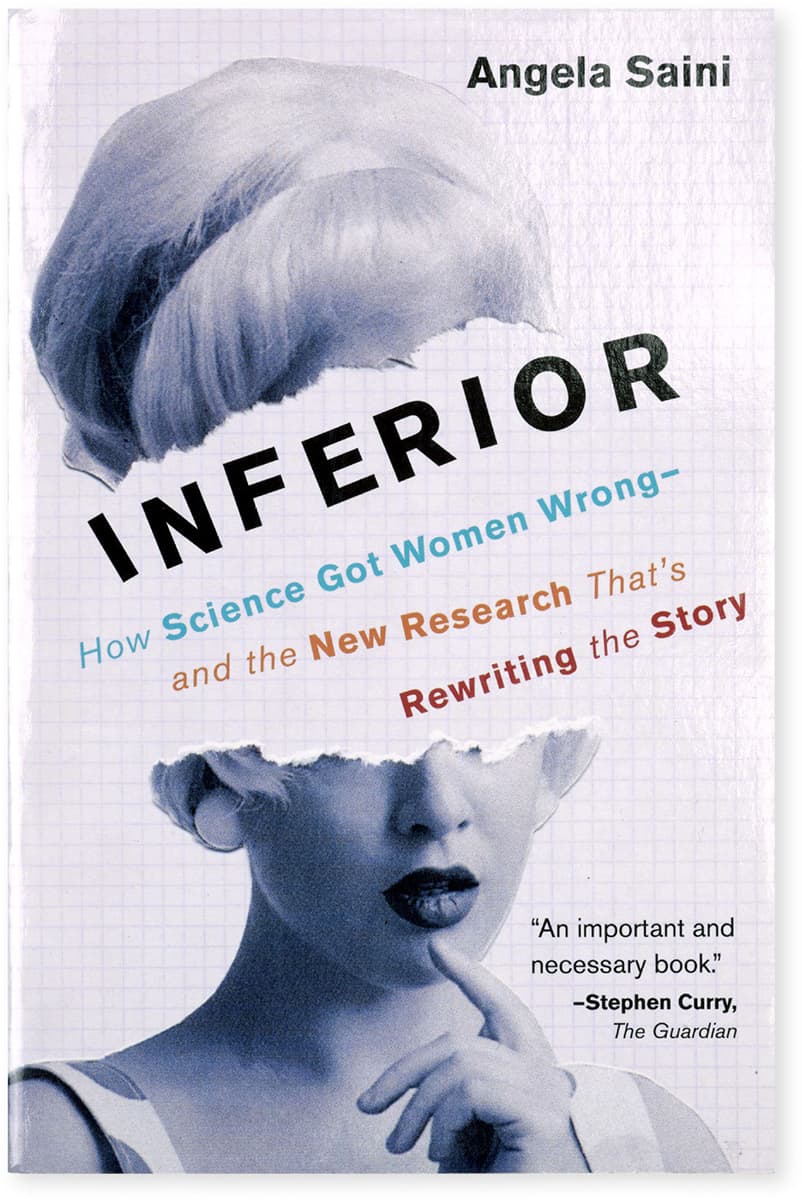
Angela Saini
INFERIOR, 2017
The intentionally controversial pink of Saini’s UK first edition published by Fourth Estate, alongside the US first edition published by Beacon Press.
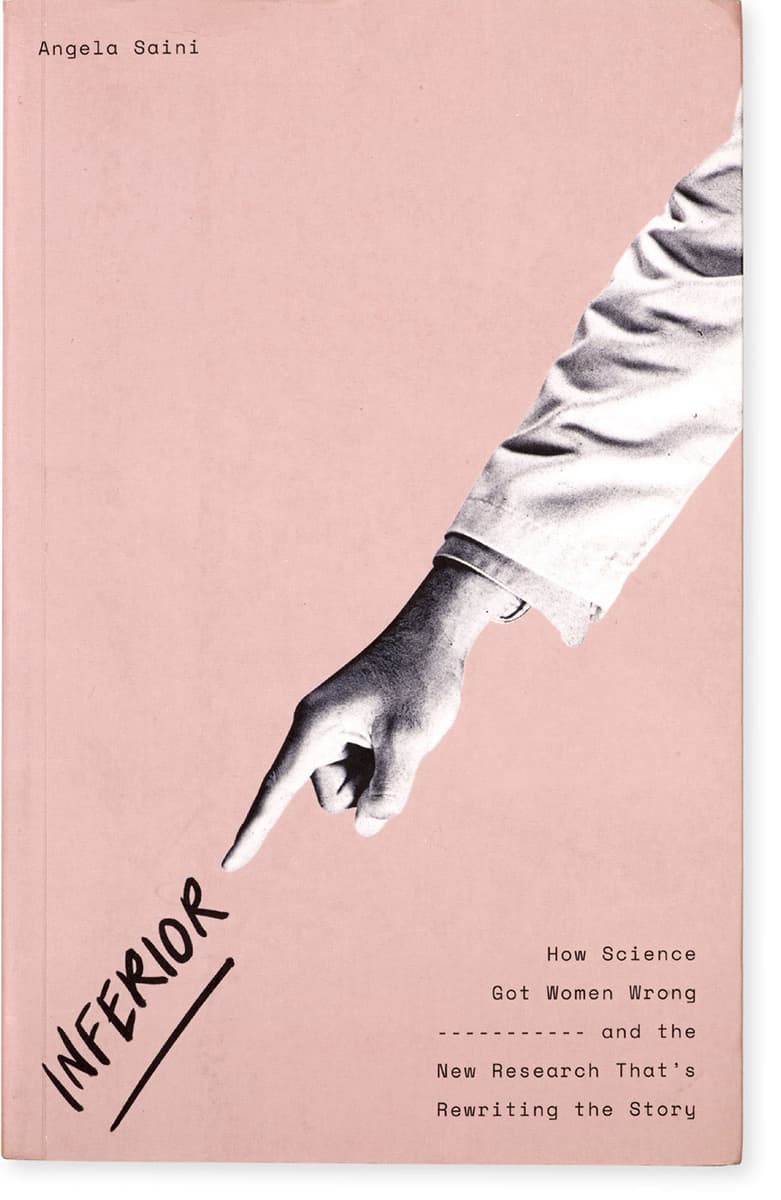
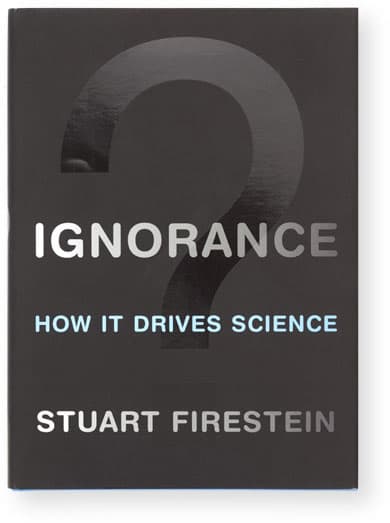
Stuart Firestein
IGNORANCE, OXFORD UNIVERSITY PRESS, 2012
A serious but approachable exploration of how science is undertaken and how we mistake its role.
As well as challenging our gender stereotypes, modern science writing has also given us important titles that question the nature of science itself and how we undertake it, in a way that is far more realistic than some of the earlier titles. One very significant book in this respect was Stuart Firestein’s Ignorance, published in 2012.
Subtitled ‘How It Drives Science’, Ignorance turns the common public understanding of science on its head, pointing out that it is not the facts that we know that are important, but rather the gaps in our knowledge, because it is these that drive science forward. Firestein comments: ‘Working scientists don’t get bogged down in the factual swamp because they don’t care all that much for facts. It’s not that they discount or ignore them, but rather that they don’t see them as an end in themselves. They don’t stop at the facts; they begin there, right beyond the facts, where the facts run out.’
This distinction between our imagined ideas of the work of scientists and what actually happens in the lab and the theory office is brought ably into the spotlight by German physicist Sabine Hossenfelder in her 2018 title Lost in Math (the book was first written in English and subsequently translated into her native German as Das hässliche Universum: Warum unsere Suche nach Schönheit die Physik in die Sackgasse führt).
Lost in Math is a powerful analysis of problems in the modern approach to physics. Until the twentieth century, experimenters made observations and undertook experiments, while theoreticians then looked for theories to explain these observations, which could then be tested against further experiments. Now, particularly in particle physics, it’s more the case that physicists dream up whole rafts of theory supported only by mathematics, much of which can never be experimentally confirmed. What can be checked is often so expensive to work on that only a very small number of possibilities can be examined.
It’s the maths that is in the driving seat, which surely is wrong. As Hossenfelder points out, string theory works best if the cosmological constant, a value that numerically reflects the rate of expansion or contraction of the universe, is negative. Unfortunately, the constant is actually positive, but most string theorists spend their time working with a negative cosmological constant. It makes for more beautiful mathematics – but has nothing to do with our universe.
Hossenfelder repeatedly comes back to two measures used to test theories: beauty, which is a subjective phenomenon, and naturalness, which appears more scientific as it involves numbers, but relies on a bizarre confidence that values in nature that are dimensionless (for example, ratios of masses) should be Goldilocks-like in not being too big or too small, but should be located around the value of 1. The physicists she interviews for the book (nearly all of them male), often cling onto these measures without being able to justify them, other than saying that everyone else likes them too.
Like Lee Smolin (see here), Hossenfelder shows that clinging to theories past their sell-by date is not surprising, because physicists are people too. If you’ve spent most of your career on a theory, you don’t give it up easily. And if hundreds of other people are working on that theory, surely it must have some substance behind it? Hossenfelder points out that in a period of about a year after the Large Hadron Collider at CERN produced data that looked interesting but turned out to be a statistical fluctuation, 500 papers were published exploring this non-event theoretically, many published in top journals.
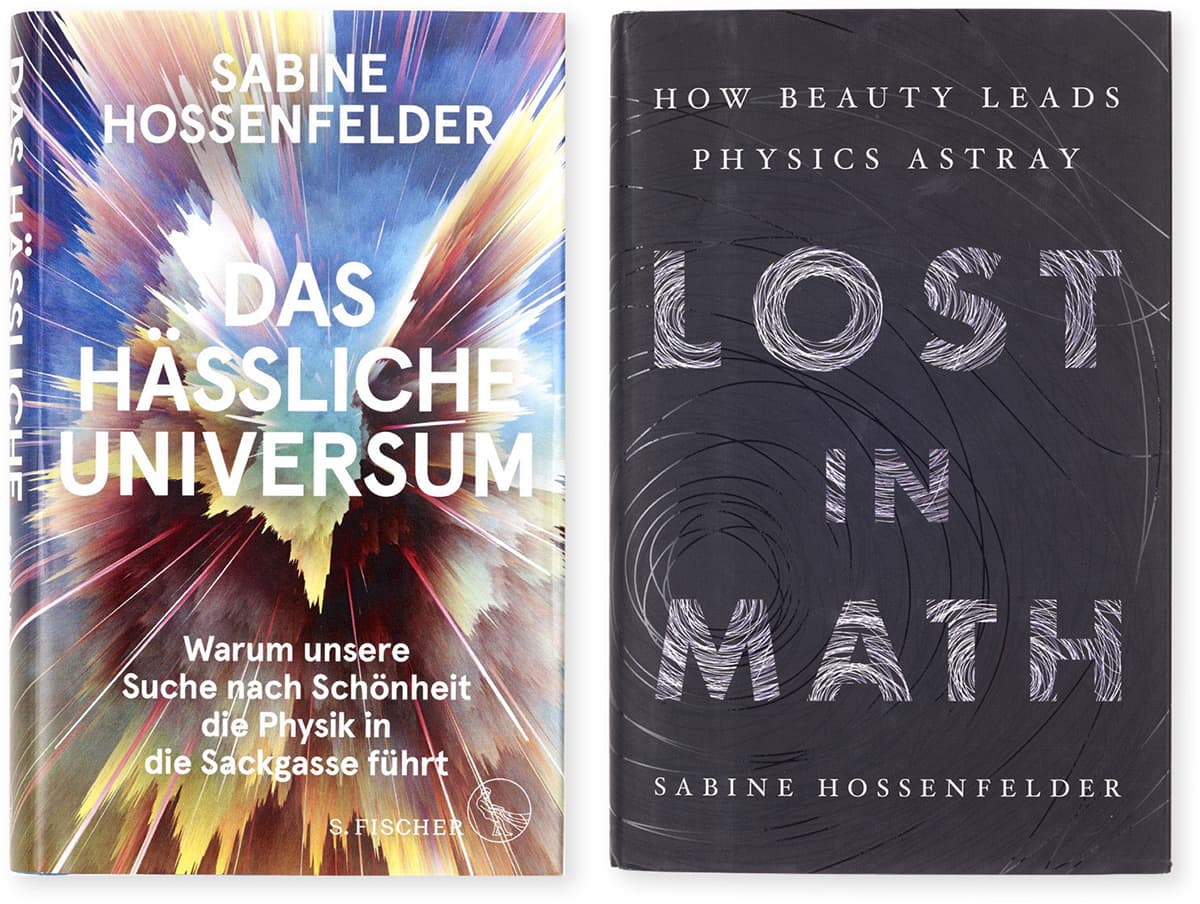
Sabine Hossenfelder
LOST IN MATH (DAS HÄSSLICHE UNIVERSUM), 2018
This title from German physicist Hossenfelder was first published in English by Basic Books before the author’s German translation later the same year, published by S. Fischer.
Lost in Math is a science book for a new age where readers are less bound by authority. This is an approach that has always benefited science. The motto of the UK’s Royal Society is Nullius in verba, roughly translating as ‘Take no one’s word for it’. In practice, the approach taken in science is closer to the Russian proverb quoted by US President Ronald Reagan in the 1980s, ‘Trust but verify’. For a long time, the general public was spoon-fed the latest theories without any attempt to qualify uncertainty. But now, we are getting more science writing that helps the reader to question theories to gain a deeper understanding.
This is not a matter of being anti-science. The best such questioning comes from scientists themselves. But it gives the reader a better, more sophisticated picture of what science is all about.
There has never been more emphasis on the importance of public engagement. We need both to encourage a deeper interest in science and to counter anti-scientific views that can go hand in hand with some types of politics. Getting the public interested in science both helps to recruit new scientists of the future and spreads an understanding of why an area of scientific research deserves funding. The best science books continue to do this, but are now able to give us a deeper, more realistic understanding of science. And surely that is a good thing.
